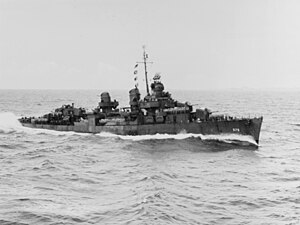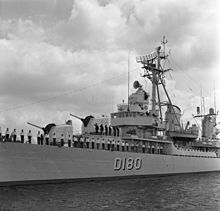USS Charles Ausburne (DD-570)
 USS Charles Ausburne (DD-570) in the vicinity of the Solomon Islands, 23 March 1944
| |
| History | |
|---|---|
| Name | USS Charles Ausburne (DD-570) |
| Namesake | Charles Ausburne |
| Builder | Consolidated Steel Corporation, Orange, Texas |
| Laid down | 14 May 1941 |
| Launched | 16 March 1942 |
| Commissioned | 24 November 1942 |
| Decommissioned | 18 April 1946 |
| Stricken | 1 December 1967 |
| Honors and awards | Presidential Unit Citation, 11 Battle Stars |
| Fate | transferred to West German Navy , 12 April 1960 |
| History | |
| Name | Zerstörer 6 (D180) |
| Acquired | 12 April 1960 |
| Stricken | October 1968 |
| Fate | Scrapped |
| General characteristics | |
| Class and type | |
| Displacement | 2,050 long tons (2,080 t) |
| Length | 376 ft 6 in (114.76 m) |
| Beam | 39 ft 8 in (12.09 m) |
| Draft | 17 ft 9 in (5.41 m) |
| Propulsion | 60,000 shp (45 MW) ; 2 propellers |
| Speed | 35 knots (65 km/h; 40 mph) |
| Range | 6,500 nmi (12,000 km; 7,500 mi) at 15 knots (28 km/h; 17 mph) |
| Complement | 329 |
| Armament |
|
USS Charles Ausburne (DD-570), a
Charles Ausburne was
Charles Ausburne's first mission which took place between 1 April and 8 May 1943 was to escort a
Guadalcanal and Solomon Islands campaigns
Sailing to the
It was on the night of 27–28 September 1943 that the enemy first felt Charles Ausburne's accurate fire, when she sank two
Her support of the
Through the remainder of November, Charles Ausburne patrolled and conducted bombardments in the Bougainville area, several times escorting resupply echelons to that island. Devastating fire poured onto the Japanese airfield at Bonis, and antiaircraft actions were fought off the beachheads, as the squadron was almost constantly underway. On 24 November 1943, while the squadron refueled in Harborn Sound, orders came to intercept Japanese forces believed to be moving down to evacuate men from Buka. Immediately, the five American destroyers then composing the squadron moved north to search the Rabaul-Buka line, and at 01:41 on 25 November, a radar surface contact was made as the squadron patrolled in St. George Channel. Charles Ausburne with two others headed in for a torpedo attack on two Japanese destroyers as Burke's two remaining destroyers provided cover. Hits disintegrated Ōnami, and broke Makinami in two. Quickly as the covering ships polished Makinami off, Charles Ausburne and the others turned to attack three destroyer transports now visible, who turned and fled with the American destroyers in pursuit. At 02:15, acting on sound estimate, Captain Burke ordered his ships to make a sharp change of course to the right to evade torpedoes. Just a minute later came the slam of torpedoes exploding in the wake of his ships. Now the "Little Beavers" opened fire on the fleeing enemy, while maneuvering to avoid return fire. As the three targets took divergent courses, Charles Ausburne continued her pursuit of Yugiri, hitting her repeatedly. Soon blazing from stem to stern, the Japanese ship made a last desperate attempt to open the range but was quickly overhauled and sunk. Approaching daylight now made it imperative that the squadron withdraw to put distance between themselves and the Japanese airbase at Rabaul. Thus ended the classic destroyer battle of Cape St. George. Three enemy ships had been sunk and another badly damaged, while no damage was received by the American ships.
Through December 1943, Charles Ausburne continued her patrol, escort, antiaircraft, and bombardment duties in support of the Bougainville operation. After brief overhaul in
From 20 February to 24 February 1944, the squadron swept the waters of New Ireland for Japanese shipping, sinking a tug, a coastal minelayer, a small freighter, and many barges, then returned to escorting amphibious craft until 5 March, when they sailed on a patrol north of the Bismarcks.
Mariana Islands campaigns
On 26 March 1944, Charles Ausburne joined the
On this mission, Charles Ausburne was at sea from 6 June to 6 July 1944, primarily steaming in the screen guarding the carriers of TF 58 as they repeatedly struck
Philippines and Okinawa campaigns
After overhaul on the west coast, Charles Ausburne returned to Ulithi 5 November 1944, and through the remainder of November guarded carriers providing air cover for convoys to
Continuing her support of the return to the
Through late March and April 1945, the destroyer screened landings at
Charles Ausburne left Okinawa 10 September 1945, and arrived at Washington, D.C., 17 October to receive her Presidential Unit Citation. After a visit to New York, she reached Charleston, South Carolina, where she was placed out of commission in reserve 18 April 1946.

German destroyer Zerstörer 6
On 12 April 1960 Charles Ausburne was transferred to the
In 1962, she was commanded by former U-boat commander
She was stricken from the U.S.
Awards
In addition to the Presidential Unit Citation awarded her squadron, Charles Ausburne received 11
Notes
Since other family members spelled their name as "Ausburn", the first ship followed that spelling. It was later found that he himself signed as "Ausburne", and the second ship's name was so spelled.
References
- This article incorporates text from the public domain Dictionary of American Naval Fighting Ships. The entry can be found here.
- Hildebrand, Hans H.; Röhr, Albert; Steinmetz, Hans-Otto (1982). Die Deutschen Kriegsschiffe: Biographien - ein Spiegel der Marinegeschichte von 1815 bus zur Gegenwart :Band 6 (in German). Herford, Germany: Koehlers Verlagsgesellschaft MbH. ISBN 3-7822-0237-6.
